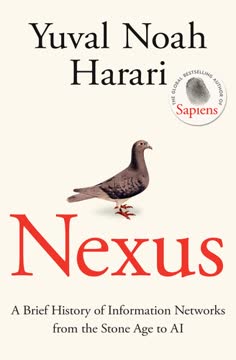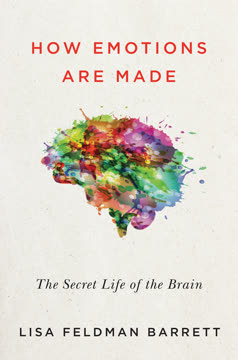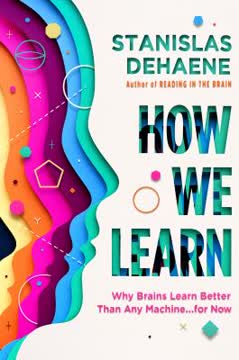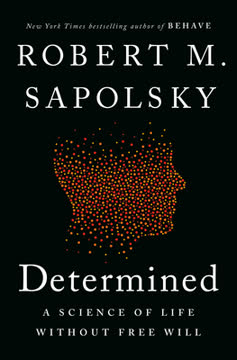つの重要なポイント
1. 意識は脳によって形作られた制御された幻覚である
私たちは常に幻覚を見ていると言っても過言ではない。ただし、その幻覚について合意したとき、それを現実と呼ぶのだ。
知覚推論。 私たちの脳は常に感覚入力の原因について予測を生成し、現実の制御された幻覚を作り出している。このプロセスは予測処理として知られ、トップダウンの予測がボトムアップの感覚信号と出会うことで成り立つ。脳は予測誤差を最小化するために、モデルを更新したり行動を通じて調整する。
ベイズ脳。 脳はベイズ原理に基づいて動作し、新しい証拠に基づいて信念を更新する。事前の期待と感覚データを組み合わせて事後確率を形成し、それが将来の知覚のための新しい事前情報となる。この予測と更新の継続的なサイクルが、私たちの意識的な世界の経験を形作る。
予測処理の主要な側面:
- トップダウン予測
- ボトムアップ感覚信号
- 予測誤差の最小化
- ベイズ推論
- 内部モデルの継続的な更新
2. 自己は不変の実体ではなく、知覚である
あなたであることは、文字通りあなたの身体に関することだ。
多面的な自己。 自己は単一の不変の本質ではなく、知覚と経験の集合体である。これには以下が含まれる:
自己の側面:
- 体現された自己(身体所有感、感情)
- 視点的自己(一人称視点)
- 意志的自己(行動の主体感と意図)
- 物語的自己(自伝的記憶とアイデンティティ)
- 社会的自己(他者の自分に対する認識の知覚)
構築された自己。 他の知覚と同様に、自己も脳によって生成された制御された幻覚である。この見方は、不変の「魂」や自己の本質という直感に挑戦し、継続的な知覚プロセスによって形作られる動的な構造として自己を明らかにする。
3. 意識的な経験は脳の予測処理から生じる
私たちは物事をそのまま見るのではなく、自分自身として見るのだ。
予測機械。 脳の主な機能は、感覚入力の原因について予測を生成することであり、単に情報を処理することではない。この予測処理は、外界の知覚から感情や自己感覚に至るまで、すべての意識的な経験の基盤となる。
能動的推論。 脳は情報を受動的に受け取るのではなく、行動を通じて予測を確認しようとする。このプロセスは能動的推論と呼ばれ、動きによって感覚入力を変え、新しい情報に基づいて内部モデルを更新することを含む。
予測処理の主要な要素:
- 生成モデル
- 予測誤差
- 精度の重み付け
- 能動的推論
4. 私たちの現実の知覚は客観的な真実よりも少なく、また多い
私たちは周囲の世界とその中の自分自身を、生きている身体を通じて、そしてそのおかげで知覚する。
選択的知覚。 私たちの意識的な経験は、進化の圧力によって生存のために形作られた、すべての可能な感覚情報の慎重に選ばれたサブセットである。これは、私たちが客観的に「そこにある」ものよりも少ないものを知覚していることを意味する。
構築的知覚。 同時に、私たちの脳は生の感覚データに豊かさと意味を加え、外部刺激の単なる反映を超えた鮮やかな内的世界を作り出す。この構築された現実には、クオリア、感情、自己感覚が含まれる。
客観的な現実から逸脱する知覚の側面:
- 色(物体の固有の特性ではなく、脳の構築物)
- 時間(持続感は主観的で可変的)
- 連続性(絶え間ない眼球運動にもかかわらず、滑らかで途切れのない世界を知覚する)
- 物体性(部分的な感覚情報から全体の物体を推測する)
5. 意識は知性よりも生きていることに密接に結びついている
私は自分を予測する、ゆえに私は存在する。
生物学的根源。 意識は、生物が生理的な整合性を維持しようとする基本的なプロセスから生じる。この「獣機械」理論は、意識を抽象的な情報処理ではなく、生物学的システムの調整ニーズに結びつける。
内受容と感情。 意識の重要な側面は、身体の内部状態の知覚、すなわち内受容である。感情や気分は、生理的条件の制御指向の知覚として理解され、行動を生存のために導く役割を果たす。
「獣機械」理論の主要な側面:
- 意識の基盤としての生理的調整
- 内受容推論
- 身体状態の知覚としての感情
- 低エントロピー状態の能動的維持
6. 意識の「難しい問題」は科学的探求によって解消できる
意識の経験におけるすべては一種の知覚であり、すべての知覚は一種の制御された、または制御する幻覚である。
実際の問題アプローチ。 意識がなぜ存在するのかという「難しい問題」に取り組む代わりに、実際の問題アプローチは、脳のメカニズムに基づいて意識的経験の特定の特性を説明することに焦点を当てる。この戦略は、理解を深める上でより実り多いことが証明されている。
メカニズムと現象学の橋渡し。 脳のプロセスと主観的経験の間に説明的な橋を架けることで、物理的現象と精神的現象の間の一見橋渡し不可能なギャップが徐々に埋まるかもしれない。このアプローチは、意識レベル、内容、自己感覚に関する洞察をすでにもたらしている。
「実際の問題」アプローチの主要な戦略:
- 現象学的特性の説明、予測、制御に焦点を当てる
- 意識の測定方法を開発する(例:摂動複雑性指数)
- 特定の意識的経験の神経相関を調査する
- 知覚と自己感覚の深層構造を探る
7. 動物の意識はスペクトラム上に存在し、人間の特異性に挑戦する
他の心を理解したいなら、頭足類の心は最も異質なものである。
意識の連続性。 意識は動物種全体でスペクトラム上に存在し、複雑さと内容の度合いが異なる。この見方は、人間の特異性の概念に挑戦し、動物の心をより微妙に理解することを促す。
多様な内的世界。 異なる動物は、その感覚システム、脳構造、進化の圧力に基づいて、根本的に異なる意識的経験を持つかもしれない。分散した神経系と独自の能力を持つタコは、動物の意識がいかに異質であるかを示す顕著な例である。
動物の意識に影響を与える要因:
- 脳の構造と複雑さ
- 感覚システムと知覚の優位性
- 進化の圧力と生態的ニッチ
- 社会的行動と認知能力
8. 自由意志は形而上学的な真実ではなく、知覚的な経験である
人は自分の意志を行うことができるが、自分の意志を意志することはできない。
錯覚的な因果関係。 自由意志の経験は、意思決定の因果構造への直接的な洞察ではなく、知覚的な推論である。私たちの主体感と意志感は、他の知覚と同様に脳の予測プロセスから生じる。
自由度の度合い。 形而上学的な自由意志は存在しないかもしれないが、人間は柔軟で自発的な行動を取る実際の能力を持っている。この信念や目標に沿った多くの自由度を制御する能力が、私たちが自由意志として経験するものである。
自由意志の議論の主要な側面:
- 両立主義 vs. 自由意志主義
- 神経科学的証拠(例:リベット実験)
- 道徳的責任と倫理への影響
9. 人工意識はAIの進歩にもかかわらず、近い将来には実現しそうにない
私たちは知的な道具を作っているのであって、同僚を作っているのではない。
知性 ≠ 意識。 人工知能の発展は必ずしも人工意識につながるわけではない。現在のAIシステムは、印象的な能力を持っているにもかかわらず、生物に意識をもたらす生物学的基盤を欠いている。
倫理的考慮。 AIがより高度になるにつれて、意識があるように見える機械の扱いや、新しい形の苦しみを生み出す可能性について倫理的な問題に直面する。予防的倫理はAI開発を導く上で重要である。
人工意識の創造における課題:
- 生物学的基盤の欠如
- 内受容と体現の再現の難しさ
- 意識の必要条件に関する不確実性
- 苦しむ可能性のある存在を作り出すことに関する倫理的懸念
10. 意識の理解は倫理と社会に深い影響を与える
科学が私たちを中心から追いやるたびに、それははるかに多くのものを返してくれる。
拡大された道徳的サークル。 人間と他の動物の意識に対する理解が深まることで、道徳的な考慮が拡大し、非人間動物や潜在的に人工的な存在の扱いに影響を与えるかもしれない。
医療と技術の応用。 意識科学の進歩は、医療(例:反応のない患者の意識の検出)、精神健康治療、脳-コンピュータインターフェースの開発に実際的な影響を持つ。
意識科学の潜在的な影響:
- 人格と権利の再定義
- 意識障害の治療の改善
- AI開発のための倫理的ガイドライン
- 精神健康と幸福への新しいアプローチ
- 変性意識状態(例:幻覚剤)の理解の向上
最終更新日:
FAQ
What's Being You: A Science of Consciousness about?
- Exploration of Consciousness: The book investigates how subjective experiences arise from biological processes in the brain and body.
- Predictive Brain Theory: Anil Seth suggests that our conscious experiences are "controlled hallucinations," shaped by the brain's predictions about sensory inputs.
- Interdisciplinary Approach: It combines insights from neuroscience, philosophy, psychology, and personal anecdotes to explore consciousness.
Why should I read Being You: A Science of Consciousness?
- Insightful Perspective: Offers a fresh perspective on consciousness, challenging traditional views and encouraging a rethink of self and reality.
- Accessible Science: Presents complex scientific ideas in an engaging manner, suitable for both lay readers and those familiar with neuroscience.
- Provocative Questions: Raises fundamental questions about identity, selfhood, and reality, prompting reflection on personal experiences of consciousness.
What are the key takeaways of Being You: A Science of Consciousness?
- Consciousness as Prediction: Consciousness is a predictive process where the brain generates best guesses about sensory inputs.
- Selfhood is Constructed: The self is a collection of perceptions and experiences shaped by biological and environmental factors.
- Reality is Subjective: Perceptions of the world are influenced by expectations and prior experiences, not direct reflections of reality.
What is the "controlled hallucination" concept in Being You: A Science of Consciousness?
- Definition of Controlled Hallucination: Perception is a "controlled hallucination," where the brain's predictions shape conscious experiences.
- Top-Down Processing: Perceptions are constructed from the brain's internal predictions rather than solely from sensory data.
- Implications for Reality: Suggests that perceived reality is a subjective interpretation influenced by expectations and prior knowledge.
How does Anil Seth define consciousness in Being You: A Science of Consciousness?
- Subjective Experience: Consciousness is defined as "any kind of subjective experience whatsoever," focusing on phenomenological properties.
- Distinction from Function: Differentiates between phenomenological aspects and functional properties, emphasizing experience.
- Hard Problem of Consciousness: Addresses the challenge of explaining how physical processes in the brain give rise to subjective experiences.
What is the "hard problem" of consciousness mentioned in Being You: A Science of Consciousness?
- Definition of Hard Problem: Coined by David Chalmers, it questions how physical brain processes result in subjective experiences.
- Contrast with Easy Problems: Easy problems involve explaining functions and behaviors associated with consciousness, like perception.
- Ongoing Mystery: Remains a central challenge in consciousness science, questioning the fundamental nature of experience.
How does Being You: A Science of Consciousness address the concept of self?
- Self as Perception: The self is a collection of perceptions and experiences continuously constructed by the brain.
- Narrative Self: Encompasses personal identity and autobiographical memories, highlighting its fluid nature.
- Embodied Selfhood: Explores the connection between physical bodies and experiences of being a self.
What is the "beast machine" theory in Being You: A Science of Consciousness?
- Definition of Beast Machine: Consciousness arises from our nature as living organisms maintaining physiological integrity.
- Predictive Mechanisms: Conscious experiences are shaped by predictive processing, with the brain making best guesses about inputs.
- Implications for Selfhood: Redefines selfhood as a perception intertwined with biological existence, not a separate essence.
What is the significance of predictive processing in Being You: A Science of Consciousness?
- Brain as a Prediction Machine: The brain constantly makes predictions about the world and our bodies, shaping conscious experience.
- Active Inference: Involves minimizing prediction errors through actions, allowing effective interaction with the environment.
- Control of Perception: Helps control perceptions, leading to a coherent experience of reality rather than mere reactions to stimuli.
What does Seth say about the relationship between consciousness and free will in Being You: A Science of Consciousness?
- Volition as Perception: Experiences of volition are forms of self-related perception, not evidence of an immaterial self controlling actions.
- Determinism and Free Will: Free will can exist within a deterministic framework, not requiring a break from determinism.
- Implications for Responsibility: Raises questions about moral responsibility, especially in cases of neurological conditions affecting control.
How does Being You: A Science of Consciousness address animal consciousness?
- Consciousness Beyond Humans: Argues that consciousness is not exclusive to humans; many animals likely have conscious experiences.
- Criteria for Consciousness: Emphasizes not judging animal consciousness solely on intelligence or language capabilities.
- Mammals and Beyond: Suggests all mammals are likely conscious, exploring potential consciousness in birds and cephalopods.
What are the best quotes from Being You: A Science of Consciousness and what do they mean?
- “We do not see things as they are, we see them as we are.”: Emphasizes the subjective nature of perception, shaped by individual perspectives.
- “We are conscious beast machines, through and through.”: Asserts that consciousness is rooted in biological existence as living organisms.
- “The self is a perception, another variety of controlled hallucination.”: Highlights the self as a dynamic construct shaped by experiences and predictions.
レビュー
『Being You』は、神経科学を通じて意識を探求し、「制御された幻覚理論」や「獣機械理論」といった理論を提唱している。セスは、私たちの知覚や自己認識は、脳が身体を調整し生存を確保するために生成する予測であると主張している。本書は、意識のレベル、自由意志、動物の意識、人工知能についても取り上げている。そのアクセスのしやすさと包括的な概要が称賛される一方で、一部のレビュアーは難解であると感じたり、説得力に欠けると感じたりする部分もあった。全体として、哲学と科学を融合させた意識研究への重要な貢献と見なされている。
Similar Books












